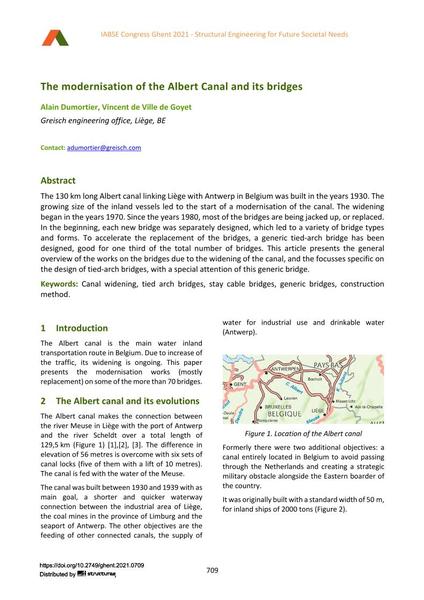The modernisation of the Albert Canal and its bridges

|
|
|||||||||||
Bibliographic Details
| Author(s): |
Alain Dumortier
(Greisch engineering office, Liège, BE)
Vincent de Ville de Goyet (Greisch engineering office, Liège, BE) |
||||
|---|---|---|---|---|---|
| Medium: | conference paper | ||||
| Language(s): | English | ||||
| Conference: | IABSE Congress: Structural Engineering for Future Societal Needs, Ghent, Belgium, 22-24 September 2021 | ||||
| Published in: | IABSE Congress Ghent 2021 | ||||
|
|||||
| Page(s): | 709-717 | ||||
| Total no. of pages: | 9 | ||||
| DOI: | 10.2749/ghent.2021.0709 | ||||
| Abstract: |
The 130 km long Albert canal linking Liège with Antwerp in Belgium was built in the years 1930. The growing size of the inland vessels led to the start of a modernisation of the canal. The widening began in the years 1970. Since the years 1980, most of the bridges are being jacked up, or replaced. In the beginning, each new bridge was separately designed, which led to a variety of bridge types and forms. To accelerate the replacement of the bridges, a generic tied-arch bridge has been designed, good for one third of the total number of bridges. This article presents the general overview of the works on the bridges due to the widening of the canal, and the focusses specific on the design of tied-arch bridges, with a special attention of this generic bridge. |
||||
| Keywords: |
tied-arch bridges construction method Stay cable bridges Canal widening generic bridges
|
||||
| Copyright: | © 2021 International Association for Bridge and Structural Engineering (IABSE) | ||||
| License: | This creative work is copyrighted material and may not be used without explicit approval by the author and/or copyright owner. |
||||
